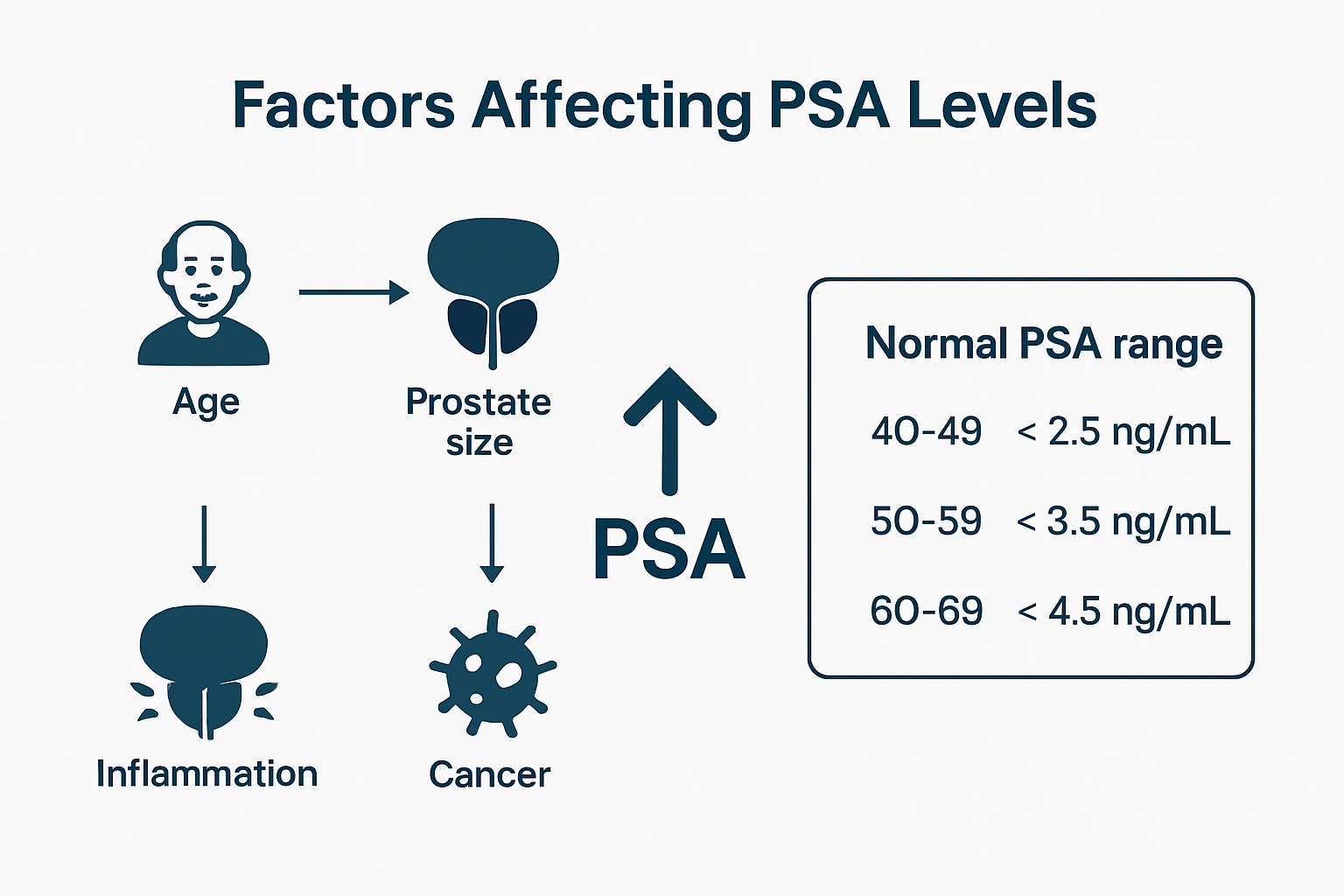PSA might sound like just another three-letter acronym, but it actually refers to a vital protein that helps monitor prostate health in men. More than two million PSA tests are carried out each year in the UK alone. Most people expect high PSA to mean cancer straight away. In reality, a raised reading can point to a whole mix of things and knowing the difference could change how you approach your health for good.

Table of Contents
Quick Summary
| Takeaway | Explanation |
| Regular PSA monitoring is essential for men’s health | Monitoring PSA levels helps detect potential prostate issues, enabling early medical intervention and improved health outcomes. |
| Elevated PSA levels require further investigation | A high PSA reading can indicate various prostate health conditions, not just cancer, necessitating additional tests for accurate diagnosis. |
| PSA testing supports personalised health strategies | Understanding PSA levels can guide healthcare providers in tailoring treatment and monitoring plans based on individual patient needs. |
| Age is a critical factor in PSA interpretation | Normal PSA ranges vary by age, making it important to compare readings with age-specific benchmarks to assess health accurately. |
| PSA screening is recommended for men aged 55 to 69 | This age group benefits most from PSA screening, as early detection can significantly affect prostate health outcomes. |
What is PSA and Why Monitor PSA Levels?
Prostate-specific antigen (PSA) is a critical protein produced by cells in the prostate gland that plays a significant role in male health monitoring. Understanding PSA requires examining its function, significance, and why regular monitoring matters for men’s wellness.
Understanding PSA Basics
PSA serves as a protein marker that helps medical professionals assess prostate health. Produced naturally by prostate cells, PSA helps liquefy seminal fluid and supports reproductive function. In healthy men, small amounts of PSA enter the bloodstream, with levels typically remaining low and stable.
According to the National Cancer Institute, PSA levels can fluctuate based on several factors:

-
Age
-
Prostate size
-
Inflammation
-
Potential cancerous changes
-
Benign prostatic conditions
To help you quickly understand the main factors that can influence PSA levels, here is a summary table based on the article content:
| Factor | Description |
| Age | PSA levels typically rise as men get older |
| Prostate Size | Larger prostates may produce more PSA |
| Inflammation | Prostate inflammation can temporarily elevate PSA levels |
| Benign Prostatic Conditions | Non-cancerous conditions like BPH can increase PSA |
| Potential Cancerous Changes | Cancer in the prostate may result in higher PSA |
| Genetic Predispositions | Family history can influence individual PSA variations |
| Recent Medical Procedures | Some procedures can temporarily affect PSA test results |
Why PSA Monitoring Matters
Monitoring PSA levels provides crucial insights into potential prostate health issues. Elevated PSA can signal various conditions, not exclusively cancer. Early detection allows for timely medical intervention, potentially preventing more serious health complications.
Key reasons for monitoring PSA include:
-
Detecting potential prostate cancer at early stages
-
Assessing risk of prostate-related health conditions
-
Tracking treatment effectiveness for existing prostate issues
-
Understanding individual prostate health trends
Regular PSA testing enables healthcare professionals to establish baseline measurements and track changes over time, providing a comprehensive view of an individual’s prostate health trajectory.
By understanding these nuanced variations, men can make informed decisions about their health and seek appropriate medical guidance when necessary.The Significance of PSA Levels in Men’s Health
PSA levels represent a critical biomarker in understanding men’s overall health, particularly regarding prostate function and potential disease risks. By providing insights beyond simple numerical measurements, PSA testing offers a nuanced perspective on male physiological wellbeing.
Interpreting PSA as a Health Indicator
PSA levels are not merely a diagnostic tool but a comprehensive health signal that reflects multiple physiological processes. Normal PSA ranges typically vary with age, making interpretation complex and requiring professional medical expertise. A single elevated PSA reading does not automatically indicate cancer, but instead signals the need for further investigation.
According to the U.S. Preventive Services Task Force, PSA screening becomes particularly significant for men between 55 and 69 years, where early detection can substantially impact health outcomes.
Below is a table that compares possible causes and interpretations of elevated PSA levels, illustrating that not all high readings point to cancer:
| Cause of Elevated PSA | Significance/Interpretation |
| Prostate Cancer | May indicate presence but not definitive |
| Benign Prostatic Hyperplasia | Non-cancerous prostate enlargement |
| Prostate Inflammation | Temporary rise, linked to infection or irritation |
| Age-related Changes | PSA can increase naturally with age |
| Recent Medical Procedures | Some interventions can cause temporary increase |
| Individual Genetic Factors | Family history may affect PSA independently |
Factors influencing PSA levels include:
-
Prostate inflammation
-
Benign prostatic hyperplasia
-
Potential cancerous developments
-
Age-related prostate changes
-
Genetic predispositions
Understanding PSA Level Implications
Comprehensive PSA monitoring provides healthcare professionals with valuable insights into potential prostate health risks. The goal is not just detecting cancer but understanding overall prostate function and potential systemic health indicators.
Key health implications of PSA monitoring include:
-
Identifying potential prostate cancer risks
-
Tracking prostate inflammation
-
Assessing treatment response for existing conditions
-
Establishing individual health baselines
By viewing PSA levels as part of a broader health narrative, men can work collaboratively with healthcare providers to develop personalised health strategies. Regular monitoring transforms PSA from a simple blood test into a powerful tool for proactive health management, enabling early intervention and informed medical decision-making.
Understanding the Role of PSA in Prostate Cancer Screening
Prostate cancer screening through PSA testing represents a sophisticated approach to early detection and preventive healthcare for men. By examining microscopic protein indicators, medical professionals can assess potential risks and develop targeted health strategies.
PSA Screening Mechanism
PSA screening involves measuring the concentration of prostate-specific antigen in the bloodstream, which serves as a crucial indicator of potential prostate abnormalities. Higher PSA levels can suggest underlying health conditions, but do not definitively diagnose cancer. The screening process requires nuanced interpretation by healthcare professionals who understand the complex interplay of factors influencing PSA levels.
According to the National Cancer Institute, PSA screening is most recommended for men between 55 and 69 years, where early detection can significantly impact health outcomes.
Key considerations in PSA screening include:
-
Individual risk factors
-
Family medical history
-
Age-related PSA variations
-
Potential for false positive results
-
Need for comprehensive medical assessment
Interpreting Screening Results
Interpreting PSA screening results requires a holistic approach that goes beyond simple numerical thresholds. Not all elevated PSA levels indicate cancer, and medical professionals must consider multiple factors when evaluating potential risks.
Important aspects of PSA screening interpretation include:
-
Distinguishing between benign and potentially cancerous conditions
-
Understanding individual baseline PSA levels
-
Recognising potential inflammatory responses
-
Assessing the need for additional diagnostic procedures
Prostate cancer screening through PSA testing empowers men to take proactive steps in managing their health. By providing early insights and enabling informed discussions with healthcare providers, PSA screening transforms potential health risks into opportunities for targeted intervention and personalised medical care.
How PSA Levels Influence Treatment Decisions and Management
PSA levels serve as a dynamic biomarker that guides medical professionals in developing personalised prostate health strategies. By offering nuanced insights into prostate condition and potential disease progression, PSA measurements become a critical tool in clinical decision-making.
Navigating Treatment Strategies
PSA levels provide essential context for determining appropriate medical interventions, transforming them from simple numerical readings into actionable healthcare intelligence. Medical professionals use these measurements to assess disease risk, treatment effectiveness, and potential progression.
According to the National Cancer Institute, PSA tracking plays a pivotal role in monitoring prostate cancer treatment outcomes and potential recurrence.
Key factors influencing treatment decisions include:
-
Initial PSA baseline measurements
-
Rate of PSA level changes
-
Velocity and doubling time of PSA increases
-
Correlation with additional diagnostic information
-
Individual patient health profile
Personalising Medical Approaches
PSA level interpretation goes beyond simple numerical thresholds, requiring sophisticated medical expertise to understand individual health trajectories. Each PSA measurement represents a snapshot of complex physiological processes, necessitating comprehensive analysis.
Important considerations in PSA-guided treatment management include:
-
Determining need for active surveillance
-
Assessing potential treatment intensities
-
Monitoring treatment response
-
Predicting potential disease progression
-
Identifying requirements for additional diagnostic procedures
By integrating PSA levels into a holistic healthcare approach, medical professionals can develop targeted, patient-specific strategies. This nuanced methodology transforms PSA from a mere diagnostic tool into a powerful mechanism for personalised prostate health management, enabling more precise and effective medical interventions.
Key Concepts Around PSA Testing and Its Interpretation
PSA testing represents a sophisticated diagnostic approach that extends far beyond simple blood measurements. Understanding its nuanced interpretation requires comprehensive knowledge of multiple physiological factors and potential variations in test results.
Fundamental PSA Testing Principles
PSA testing is not a definitive cancer diagnosis tool, but rather a complex screening method that provides critical insights into prostate health. Medical professionals carefully evaluate PSA results within a broader contextual framework, considering multiple interconnected factors that influence protein concentration.
According to the National Cancer Institute, PSA testing involves understanding various sources of potential variation in test results.
Key factors influencing PSA test interpretation include:
-
Age-related physiological changes
-
Prostate size and structure
-
Potential inflammatory conditions
-
Recent medical procedures
-
Individual genetic predispositions
Comprehensive Result Evaluation
Interpreting PSA test results requires a holistic approach that transcends simplistic numerical thresholds. Each PSA measurement represents a dynamic snapshot of complex physiological processes, necessitating sophisticated medical expertise to understand potential health implications.
Critical considerations during PSA result analysis include:
-
Distinguishing between benign and potentially malignant conditions
-
Tracking PSA level changes over time
-
Correlating results with additional diagnostic information
-
Assessing individual risk profiles
-
Understanding potential testing limitations
By approaching PSA testing as a nuanced diagnostic tool, healthcare professionals can develop more precise, personalised health strategies. This comprehensive methodology transforms PSA testing from a singular measurement into a powerful mechanism for understanding individual prostate health trajectories and potential future interventions.

Take Control of Your Prostate Health Today
Understanding PSA levels is crucial to detecting and preventing serious prostate health issues before they develop further. Many men worry about missing early warning signs or waiting too long for answers. As discussed in the article, monitoring your PSA with regular testing gives you clarity, reassurance, and the power to act quickly if your levels change.

Why wait to get the important information your body is telling you? With Lola Health, you can order an at-home blood test or book a nurse visit for fast PSA monitoring, all reviewed by doctors and processed in trusted NHS-standard labs.
Visit our Blood Tests page to get started now and gain confidence in your health with results you can trust.Frequently Asked Questions
What is PSA and why is it important to monitor its levels?
Prostate-specific antigen (PSA) is a protein produced by prostate cells, and monitoring its levels is crucial for assessing prostate health, detecting potential cancer, and understanding overall male wellness.
What factors can influence PSA levels?
Several factors can affect PSA levels, including age, prostate size, inflammation, benign prostatic conditions, and changes associated with cancer.
How often should men have their PSA levels tested?
Men, particularly those aged between 55 and 69, should consult with their healthcare provider for personalised recommendations regarding the frequency of PSA testing based on individual health risks and family medical history.
Can a single elevated PSA reading confirm prostate cancer?
No, an elevated PSA reading does not automatically indicate prostate cancer. It signals the need for further investigation, as elevated levels can also result from benign conditions or other factors.


